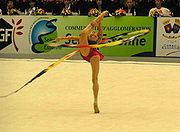.gif)
Ribbon (rhythmic gymnastics)
Encyclopedia

Rhythmic gymnastics
Rhythmic gymnastics is a sport in which individuals or teams of competitors manipulate one or two pieces of apparatus: rope, clubs, hoop, ball, ribbon and Free . An individual athlete only manipulates 1 apparatus at a time...
.
The stick
.jpg)
Bamboo
Bamboo is a group of perennial evergreens in the true grass family Poaceae, subfamily Bambusoideae, tribe Bambuseae. Giant bamboos are the largest members of the grass family....
, plastic
Plastic
A plastic material is any of a wide range of synthetic or semi-synthetic organic solids used in the manufacture of industrial products. Plastics are typically polymers of high molecular mass, and may contain other substances to improve performance and/or reduce production costs...
or fibreglass with a maximum diameter of 1cm (2/5") at its widest, a cylindrical or conical shape and should have a length of 50–60cm (20–24") (including the fastening ring). The bottom end of the stick may be covered by an adhesive, anti-slip tape or may have a rubber handle for a maximum length of 10cm (4") at the level of the grip. The top of the stick, where the ribbon will be attached, may consist of:
- a supple strap (of string or nylon) held in place by a nylon thread wound round the stick for a maximum 5cm (2").
- a metal ring fixed directly onto the stick.
- a metal ring (vertical, horizontal or oblique) fixed to the stick by two metal pins held in place by nylon or metallic thread round wound around the stick for the maximum 5cm (2").
- a metal ring (fixed, mobile or pivoting) or a supple strap, fixed to a metal tip of no more than 3cm (1.2").
- a metal ring fixed by two metal pins held by a metal tip of 3cm long that is lengthened by nylon or metallic thread wound around the stick adding up to a maximum length of 5cm (2").
The Ribbon
The Ribbon is made of satinSatin
Satin is a weave that typically has a glossy surface and a dull back. It is a warp-dominated weaving technique that forms a minimum number of interlacings in a fabric. If a fabric is formed with a satin weave using filament fibres such as silk, nylon, or polyester, the corresponding fabric is...
or another similar material cloth of any colour, it may be multi-coloured and have designs on it. The ribbon itself must be at least 35g (1 oz), 4–6cm (1.6–2.4") in width and for senior category a minimum length of 6m (20') (5m (16.25') for juniors).
The ribbon must be in one piece. The end that is attached to the stick, is doubled for a maximum length of 1m (3'). This is stitched down both sides. At the top, a very thin reinforcement or rows of machine stitching for a maximum length of 5cm is authorized. This extremity may end in a strap, or have an eyelet (a small hole, edged with buttonhole stitch or a metal circle), to permit attaching the ribbon.
The Attachment of the Ribbon to the Stick
The ribbon is fixed to the stick by means of a supple attachment such as thread, nylon cord, or a series of articulated rings. The attachment has a maximum length of 7cm (2.8"), not counting the strap or metal ring at the end of the stick where it will be fastened.Elements
Compulsory elements for the ribbon include flicks, circles, snakes and spirals, and throws. It requires a high degree of co-ordination to form the spirals and circles as any knots which may accidentally form in the ribbon are penalised and any elements done while there is still a knot in the ribbon acquire additional deductions. During a ribbon routine, large, smooth and flowing movements are looked for.External links
- Asaf MessererAsaf MessererAsaf Mikhailovich Messerer was a Russian Jewish ballet dancer and ballet teacher. He was born in Vilnius, Lithuania. From 1919 until 1921 he trained as a dancer at the Bolshoi Ballet School under Mikhail Mordkin...
, soloist (1940): Ribbon Dance, Music by Reinhold Gliere (1875-1956), Choreography by Messerer and Lashchulin, Open Source Movies

